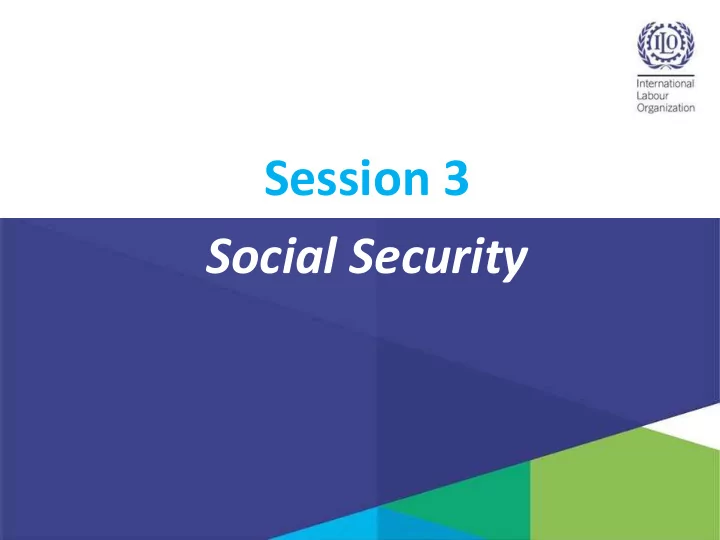

Session 3 Social Security
Learning Objectives 1. List the main features of the national social security system 2. Recognize the most common forms of informal employment at national level 3. Identify factors that influence labour market outcomes for young workers
What is is social security? Unemployment Work injury Medical care Maternity Sickness Invalidity Families with Death of the Old age Life- children breadwinner cycle
Typ ypes of socia ial transfers All social security benefits represent social transfers ( cash or in kind) Social transfers Non- Contributory contributory Compulsory Voluntary Targeted Non-targeted Social insurance Social Universal Targeted to informal insurance schemes social sector assistance Some microinsurance
Indonesia – Sistem Jaminan Sosial Nasional UU 40/2004 UU 24/2011 PP 44/2015 PP 45/2015 PP 46/2015 PP 109/2013
Activity: Life scenario: Hoping for the best, preparing for the future 2 teams Each team reads the story of Rose and develops 2 scenarios: 1/ Optimistic (all goes well) and 2/ Pessimistic (all goes wrong) Each team explores the advantages and disadvantages of participating in the insurance system
Social Protection http://www.thatsitcom.co.za/tag/brand-objectives/
(i) Consumption Smoothing • transfer consumption from higher income moments to lower income moments • choose a better time path of consumption over active and non active periods Income min Age Source: http://www.protectyournestegginretirement.com/retirecalc/ 8
(ii) Insurance Support To live better in a world individuals and dominated by uncertainties businesses When will someone get sick? When will my employee get pregnant? How long will I live after retirement? How will the economy perform? What will be the inflation?
(iii) Redistribution • Formulas can provide low earners with a higher percentage Within the of their previous earning same • Subsidize the consumption from who is less well-off but generation not necessarily poor • Promoting a transfer from the future to the current generation Between • By setting a lower contribution rate in the early stages generations • Expecting that future generations will have higher wages due to economic growth and productivity increases
(iii) Poverty relief For those who do not have the Transfers capacity to earn enough resources
Potential Economic Impact Increases consumption Promotes domestic demand Creates market for businesses Automatic Stabilizer Reducing vulnerability to external shocks Economic transformation
Economic Impact? What more? Allows people and businesses to take more risks Key to increase profits and returns Related with economic transformation Motivational impacts Workers feeling saver / more protected feel more motivated , enhancing workers productivity and business profits
SP is an investment Human K development International data shows Higher use of health services Improved health status (physical and psychological) and less absenteeism Better nutritional status Higher school attendance Higher educational results All this lead to HIGHER PRODUCTIVITY – key for competitiveness
Thank you grace@ilo.org
ILO’s norms for implementing the right to SS C 118 Equality of Treatment (Social Security) Convention, 1962 C 157 Maintenance of Social Security Rights Convention, 1982 C.102 Social Security (Minimum Standards) Convention, 1952 R67 Income Security Recommendation, R69 Medical Care 1944 Recommendation, 1944 C 121 C 128 C 130 C 168 C 183 C 19 Employment Invalidity, Medical Care Employment Maternity Equality of Injury Benefits Old-Age and and Sickness Promotion and Protection Treatment Convention, Survivors' Benefits Protection Convention, 2000 (Accident 1964 Benefits Convention, against Compensation), Convention, 1969 Unemployment 1925 1967 Convention, 1988 R. 202 Social Protection Floors Recommendation, 2012 (No. 202)
Convention No. 102 Regroups the nine classical social security contingencies into a single comprehensive and legally binding instrument . Serves as a benchmark and reference Sets out principles that guide the design, financing, governance and monitoring of national social security systems
Guiding international principles Universality Adequacy Sustainability Transparent and Entitlement to Predictability accountable benefit by law management Solidarity through Inclusive Social inclusion collective participation financing
What is Social Security? Social Security is the protection that a society provides to individuals and households to ensure access to health care and to guarantee income security, particularly in cases of old age, unemployment, sickness, invalidity, work injury, maternity or los of breadwinner.
Main elements of Social Security Systems - Social insurance - Social assistance - Benefits from general revenues - Family benefits - National provident funds
Social Security Convention, 1952 Convention 102 indicates minimum requirements as to coverage of the population; content and level of benefits; and protection of the rights of contributors and beneficiaries. In 2012, the International Labour Conference adopted the Social Protection Floors Recommendation (No. 202) which prioritizes the establishment of national floors of social protection accessible to all
Social Security benefits - Medical care - Sickness Benefit - Maternity Benefit - Unemployment benefit - Employment injury benefit - Invalidity benefit - Old-age benefits
Discussion Points What are the general characteristics of the social security framework in your country? Do you think the framework itself is adequate to provide basic social protection for workers? What is the level of participation amongst the workforce? Can you suggest any improvements that could be made to render social security better and more effective?
Discussion Points In what ways does social security contribute to economic and social progress in the country? What social insurance issues do you think are the most important for young workers, and why? What are some of the characteristics of the informal economy in your country? How might informal economy workers be able to move towards formal employment, and therefore have better access to social security?
Discussion Points Do you have any plans as to how you will live, once you have retired? How much money do you think it will take and where do you expect that money to come from? What measures do you anticipate taking to ensure that you are able to live in a decent manner after retirement?
Recommend
More recommend